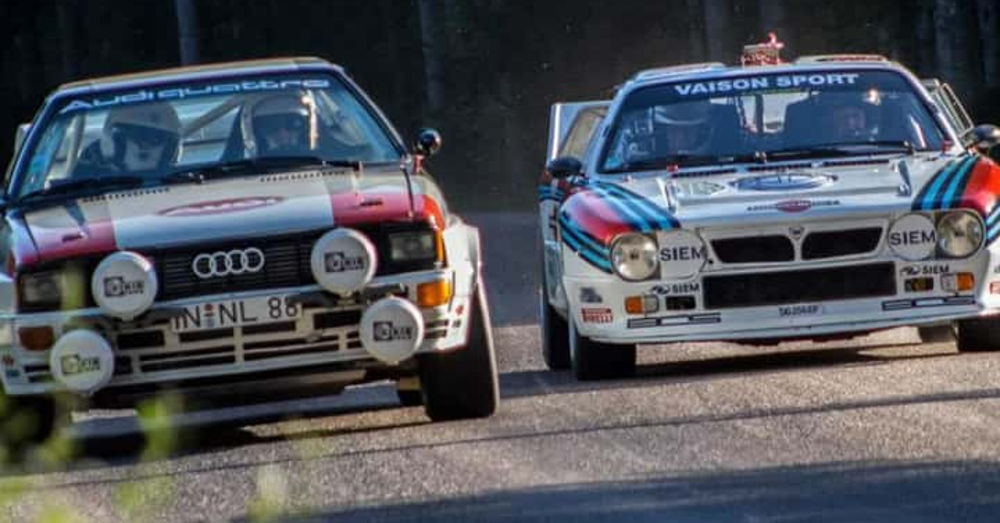Lancia is a brand name you don’t hear about any longer, but at one time, Audi and Lancia went head to head on the World Rally Championship stage.
Racing team toured the world competing on the many dirt-covered tracks that make up the World Rally Championship races. Many of these courses still exist today, and in the heyday of the sport, two names truly set the mark for these races and what brands could do. These courses are where the Audi Quattro gained notoriety, and Lancia attempted to take down the German juggernaut.
WRC is where manufacturer wins reign supreme
Many times, automakers put together several teams to compete on the world stage. This was the case for both brands in the WRC, as it was in many other motorsports races. These two names are among the top performers in this sport during a time when it was transitioning. Here’s how each brand fared during the days when they took several crowns.
Audi
Twice, Audi won seven of the World Rally Championship races, which was a truly impressive feat. The two years in which this occurred were 1982 and 1984. During these two years, Audi also won the manufacturer’s title, although only two drivers won for the brand.
The team that won in 1982 was made up of Stig Blomquist, Hannu Mikkola, and Michele Mouton, while the 1984 team had the same members but added Walter Rohrl to the mix. In 1984, Audi grabbed all three podium positions in the first two rounds in Monte Carlo and Sweden.
By 1984, the opposition was better than in 1982, but the Audi Quattro 4WD system was something to truly behold on the rally championship racing stages.
Lancia
Lancia was the only reason that Audi didn’t win the WRC Group B championship in 1983. That said, the 1983 season wasn’t Lancia’s best. The Stratos was extremely popular on that stage, but the Group A series with the Lancia Delta HF and then Integrale were more successful than the Stratos.
Lancia won six manufacturers’ titles when Group A was begun. They added four drivers’ titles to the mix during that same time. The most successful year for Lancia was 1988, but 1987 was also impressive. In 1987, Lancia won nine of the rallies and followed this up with ten wins during 1988. This meant that the Delta didn’t win a rally stage only three times during 1988, quite an impressive feat.
In fact, this feat was so impressive that the record was held for 17 years until Citroen broke it.
Lancia pulled out the tricks that Audi didn’t require
In order to be the champion in 1983, Lancia first had to prove it was a big enough name to enter these races. The Lancia 037, or Stratos, was the car that would compete, but there was some uniqueness to this story. An episode of The Grand Tour covers many of the differences between the startup Lancia and the dominant force of Audi during that time.
The Lancia car was lighter and only used RWD instead of an AWD system found in the Audi Quattro. Of course, that wasn’t the greatest part of the story. During the story, which truly shows a David vs. Goliath type of battle, Lancia had to show it had built the required number of cars. To do this, they told inspectors that half of the cars were in one lot while the other half was across town. While going from one lot to the other, Lancia had enough drivers move the first set of cars to the second lot, where the cars were counted twice. This was one of the most significant tricks the brand pulled out to qualify for this racing series.
Group B was the perfect place for Audi and Lancia
The first year for Group B in the WRC was 1982. This new class allowed racing teams to build cars however they desired with minimal restrictions. This racing class was a bit of a wild west when it came to the rally racing.
The only rules to note were the requirement for two seats. A car’s weight was calculated by engine displacement. There wasn’t any restriction on boost, and all body materials were permitted.
None of the cars that were freshly built for Group B scored a podium in any race during the inaugural year, which put Audi at the top of the podium, where it had been during Group 4 racing with the Quattro. As you know, things changed the next year, and we were off for a few years of wild racing in Group B until it was ultimately shut down after the 1986 season.
This post may contain affiliate links. Meaning a commission is given should you decide to make a purchase through these links, at no cost to you. All products shown are researched and tested to give an accurate review for you.

